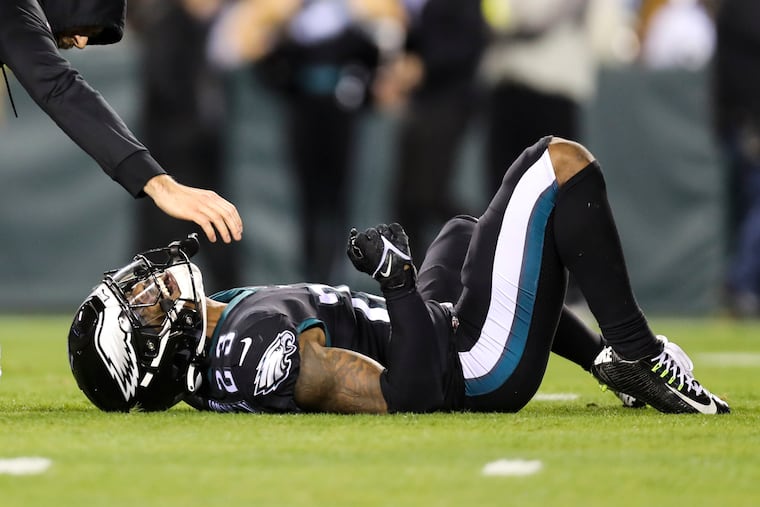What to know about Eagles safety C.J. Gardner-Johnson’s kidney laceration
About three NFL players injure a kidney every season, according to 2008 study from the American Journal of Sports Medicine. Here is what you need to know about this type of injury.

On Sunday night, the Eagles defense got a blow straight to the kidney. C.J. Gardner-Johnson’s kidney, to be precise.
The 24-year-old safety suffered the injury during the Eagles’ victory over the Green Bay Packers. On Tuesday, a league source confirmed to The Inquirer an NFL Network report that Gardner-Johnson had a lacerated kidney. The injury does not require surgery and Gardner-Johnson is expected to return to the field this season, according to the report.
Gardner-Johnson isn’t the first NFL or Eagles player to suffer a lacerated kidney in recent years. In 2019, Eagles tight end Zach Ertz missed a game with the same injury. In November 2015, two NFL players — Indianapolis Colts quarterback Andrew Luck and San Diego Chargers receiver Keenan Allen — suffered lacerated kidneys one week apart.
About three NFL players have kidney injuries every season, according to a 2008 study by the American Journal of Sports Medicine. Here is what you need to know about this type of injury.
What is kidney laceration?
A cut in the kidney caused by blunt trauma.
Most people have two kidneys, located toward the back of their abdomen. Kidneys are partially protected by the ribs, a layer of fat, and another protective layer that Daniel Eun, a urologist at Temple University Hospital, described as “like a Ziploc bag that holds the organ in place.”
“There is a very strong and natural defense for the kidneys,” he said.
» READ MORE: Eagles safety C.J. Gardner-Johnson has a lacerated kidney, but could still return this season
But blunt force — such as in a car accident or sports injury — can jolt the kidney. When that force is strong enough to cut the organ itself, that’s called a laceration.
Kidney injuries are graded on a scale from one to five, from minor bruising to wounds that tear apart the organ.
Lacerations can range in depth but most are small cuts that don’t impact the kidney’s urine collecting system or the blood vessels around it, Eun said.
What are the symptoms of a kidney laceration?
Blood in the urine and pain in the lower back or abdomen, where the kidneys are located, can indicate kidney lacerations.
Eun took his son to Lincoln Financial Field on Sunday night to watch the Eagles beat the Packers. Even from the stands, the Temple urologist could tell by the way Gardner-Johnson walked off the field that he was in pain.
When former Eagles wide receiver Miles Austin had a lacerated kidney in the 2014 season while playing for Cleveland Browns, he didn’t have a lot of pain at first. But after the postgame interviews, he stood at the urinal and saw a red rich stream.
People with more severe lacerations may show signs of significant blood loss — pale skin, reduced blood pressure, dizziness — if blood vessels around the kidney were cut as well, Eun said.
Kidney laceration is diagnosed with a CAT scan that can show the cut and its depth.
How is a lacerated kidney treated?
Most lacerated kidneys are treated with rest and observation, said Rodney Durham, a trauma surgeon with Main Line Health.
“The major thing is that you don’t want to have any more trauma to the kidney,” he said.
That’s why players are out for a few weeks after these injuries. More severe lacerations may require surgery to stop bleeding. If the kidney is no longer able to function, it might have to be removed, he said.
» READ MORE: Living with kidney disease, hope for the future
How long does it take to recover from a kidney laceration?
Most patients make a complete or near-complete recovery in four to six weeks with no long-term consequences, experts said.
“The kidney is an incredibly resilient organ,” Eun said.
When the laceration is deeper, or involves blood vessels, long-term damage becomes a concern. Kidney damage could lead to high blood pressure or require dialysis or a kidney transplant.
What to make from the news on Gardner-Johnson?
If he doesn’t need surgery, that’s good news for his kidney and the Eagles defense, said Eun, who did not examine or treat Gardner-Johnson.
“C.J. will be able to have a good recovery hopefully,” he said.